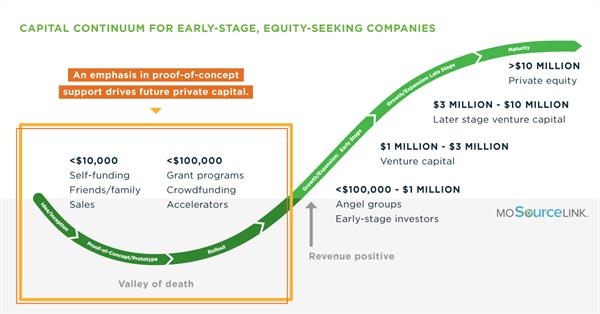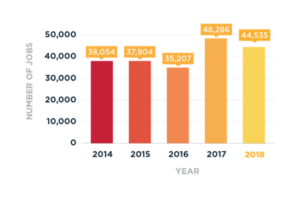
New Report Reveals Funding Gaps For Missouri Early-stage Companies
6 key goals can drive financing and capital to Missouri startups.
Missouri is leaving millions of dollars on the table that could fuel early-stage startups, which create nearly 80% of net new jobs in the state. A new report from MOSourceLink, a program of the UMKC Innovation Center, reveals Missouri is lacking in alternative loans, access to resources, early-stage capital and locally activated venture capital.
The good news: It’s clear what needs to be done to fill the gaps in the early-stage financing for startups.
MOSourceLink’s Show Me Capital: Financing Early-Stage Companies in Missouri maps the state’s capital landscape. The report reveals key gaps in both the debt and equity finance systems, draws on funding and financing activity across the state and analyzes data from more than 30 loan programs, 600 grant and equity investments and 50 venture capital firms. The report reflects the state of capital as of December 2019.
“At MOSourceLink, we not only connect entrepreneurs to resources, we also build collaborations to fill gaps in entrepreneurial services,” said Alexces Bartley, network builder for MOSourceLink, a statewide network of 500+ entrepreneurial service providers. “Show Me Capital reveals what’s really happening with loans and equity for early-stage businesses in Missouri and, more importantly, what we can do together to improve the situation.”
Download a copy of the Missouri Capital report here. Findings for Missouri’s Capital Landscape include:
- Missouri needs more alternative loans, especially in rural areas: While a number of organizations have alternative loan funds, many of those resources are underutilized and/or underfunded.
- The pipeline of growth companies needs support at the early stages. Grants play a critical role by fueling companies too new for investors who often expect immediate returns. Data from programs like Digital Sandbox KC prove that investing in companies’ earliest stages helps them survive the “valley of death” and leads to follow-on funding. Federal grants are one avenue for early-stage funding, but Missouri lags compared to leading states in taking advantage of federal research grants (SBIR/STTR).
- Missouri companies need better access to equity-stage investment. While Missouri compares favorably to some neighboring states in venture capital raised, it lags behind others. Also, Missouri-based VC funds invest in early-stage companies, but not necessarily those based in Missouri.
“Capital is critical to get innovations off the ground and get customers in the door. Nearly 60% of new business owners bootstrap their business with personal savings, which leaves out those aspiring entrepreneurs who don’t have personal wealth to lean into,” said Jim Boyle, co-founder of Justine PETERSEN, the largest player in microlending in Missouri. “Increasing the accessibility of microloans removes a barrier to the hope and economic mobility of entrepreneurship.”
In 2015, KCSourceLink published a similar study of data and action steps for the Kansas City market, We Create Capital. The community rallied around those goals and in less than five years, Kansas City saw a 61% increase in early-stage deals, a 290% increase in available capital for KC entrepreneurs and gathered critical data on the impact early-stage funding mechanisms have on later-stage funding.
“Investment in innovation is critical to Missouri’s economic development strategy,” said Rachel Anderson, director of efactory, an entrepreneurship and business resource center in Springfield, Missouri.
“Networking capital across the state – connecting investors and entrepreneurs together and making the mechanisms to do that more visible – will help bridge the gap between rural and urban entrepreneurship and continue to raise the profile of Missouri.”
Six Goals to Improve Access to Capital for Early-Stage Companies
The study sets out six bold goals and supporting action that, if the community embraces, can drive significant dollars to support Missouri startups:
- Increase the availability of alternative loans for early-stage businesses in Missouri that are not yet eligible for traditional bank loans from $18MM in 2018 to $31MM by 2025.
- Secure $2MM per year of proof-of-concept grants to support a minimum of 80 Missouri proof-of-concept projects per year by 2025.
- Increase the amount of Missouri SBIR funding from $20MM to an average of $25MM per year by 2025.
- Double seed capital investments (under $1MM) from $13MM in 2018 to more than $26MM per year by 2025.
- Increase venture capital investments ($1MM – $10MM) from $122MM to more than $250MM per year by 2025.
- Activate the statewide network of resources for entrepreneurs and small businesses to improve access to capital; connect with and educate residents on how to access available capital.
“The message is clear: we need to connect and activate capital of all types at all stages to support our Missouri businesses, especially those in the very early-stages,” said Ben Johnson, vice president, programs at BioSTL, a collaborative group of St. Louis civic, academic and business leaders who support medical and plant science innovation.
“Access to the right capital at the right time is often the critical difference between those who survive the ‘valley of death’ to generate revenues—and those businesses that fold.”
Download a copy of the Missouri Capital report here











